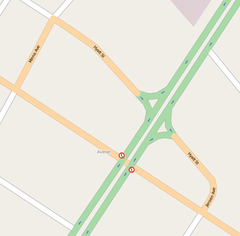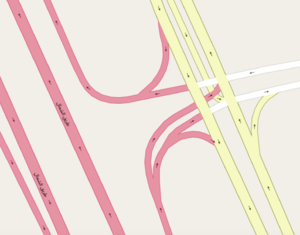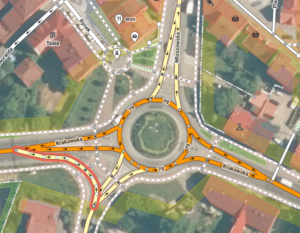Ko:Highway link

|
| 설명 |
| 도로를 연결하는 것을 나타내는 도로 태그 |
| 그룹 |
| 태그 |
|
|
_link 태그들은 진입로 혹은 램프와, 도로 본선과 다른 도로를 연결하는 "독립"된 (물리적으로 분리된) 평면 교차로의 좌우 회전 차로처럼 연결 도로를 나타내는 데 사용합니다. 연결로는 연결되는 도로가 아니며 그 도로들 사이의 연결을 형성합니다. '_link 태그는 신호 교차로에서 물리적으로 분리된 좌우 회전 차로에, 회전 교차로에서는 물리적으로 특정 방향으로의 회전을 위해 독립된 차로인 경우에만 사용하여야 합니다.
연결 도로의 종류는 아래와 같습니다.
highway=motorway_linkhighway=trunk_linkhighway=primary_linkhighway=secondary_linkhighway=tertiary_link
태그
연결 도로를 쪼개 각각의 연결로로 다르게 분류하지 마세요. 이는 연결로가 연결하고자 하는 도로가 어떤 도로인지 알기 어렵게 합니다.
연결로는 보통 이름이 없습니다. 교차하는 도로의 ref=*와 표지판에 적힌 목적지를 보여주기 위해서는 destination=* 태그 등을 사용하여 경로 탐색기가 연결 도로로 진입하면 어느 방면으로 가는지 올바로 안내할 수 있게 해 주세요. 영국과 미국의 회전 차로/램프의 경우 보통 이름이 없고, 아주 소수만 도로 번호가 있습니다. (만약 번호가 있는 경우 대부분 중첩 구간이 시작하거나 끝나는 곳입니다.[1])
입체교차로
입체교차로에서는, 몇몇 주요 교통 흐름이 다른 도로를 위나 아래로 통과합니다. 이는 주로 도로를 가로질러 횡단 교통을 제거합니다(주로 고속도로). 고속도로끼리의 분기점에서는, 모든 평면 횡단이 사라집니다 (그럼에도 영국에서는 간혹 회전교차로로 두 고속도로를 교차시키기도 합니다.) 입체교차하면서 평면교차로가 있는 나들목이 아주 조금은 있습니다.[2]
회전 차로/램프는 주로 드나드는 통과 도로에 속해 있다고 간주됩니다. 이는 주로 교차하는 도로의 더 높은 분류인데, 진출입 램프는 보통 도로 본선과 같은 종류의 제한을 가지고 있기 때문입니다. 하지만 몇몇 상황에서는 반대의 상황일 수도 있습니다.
-
램프가 더 낮은 등급의 도로에 '속해' 있다고 여겨지는 아주 덜 흔한 사례 –
highway=tertiary_link로 전부 태그되어 있습니다. -
A very unusual double trumpet interchange bundled with a road maintenance facility and police station. Here the notion of "belonging" is more ambiguous and disputable. In this particular case, the link classifications are exceptionally mapped as "split in half", due to different access restrictions and road rules.
Some communities (e.g. Russian) do not make distinction between links and main roads in status selection. It usually results in a link tagged by a lower classification of the intersecting highways, though in some cases link status can be even lower.[3]
평면교차로
The most common type of _link cuts the corner at an intersection, leaving a small triangular "island" between it and the through carriageways/through lanes.
Internal turning lanes
Other common types of _link roads are also physically separated turning lanes in the central reservation/median of dual carriageways/divided highways.[4] They should be tagged with the _link classification of the highest classified road they connect to.
Preexisting Roads as Links
Sometimes, more complicated arrangements of links connect highways to each other, much like an interchange without bridges. Usually these eliminate direct left turns (see jughandle). Standard at-grade junctions in Spain require vehicles to exit right before making a left turn. Here too it probably makes more sense to consider the links as "belonging" to the more major highway.

Note that a regular surface road may be used for the same purpose. A preexisting street used to connect two major highways is not a link. Instead it should be tagged as the normal highway it previously was, probably equivalent to the lower classification of the ones it connects. This also applies where otherwise minor streets connect highways at an interchange.[5]
Similarly, a minor road that intersects a dual-carraigeway road with a higher classification is not a link between the two major road halves, and should be tagged as normal.[6]
회전교차로

highway=* valueLinks are also used in roundabout designs that physically separate a specific turn from the main roundabout. Note that it applies to additional carriageways present on some roundabouts, not standard split on a typical roundabout.
고속도로에 대한 특별한 고려
몇몇 국가에서는 (예를 들어 영국, 하지만 미국에서는 예외 있음), 고속도로에 특정 종류의 차량(자전거 등)과 운전자(연습자 등)는 고속도로를 이용할 수 없다는 법적 암시가 있습니다. 동일한 제약이 motorway_links에도 적용됩니다. 따라서 motorway_link는 그러한 규제가 적용되는 연결 도로에 사용되어야 합니다.
다른 곳에서는, 고속도로의 일부를 이용해야 접근할 수 있는 램프는 motorway_links여야 합니다. Also, collector/distributor roads are motorway_links when they collect and distribute motorway traffic.[7]
A motorway may have a short ramp of the turning lane type normally seen at a surface intersection, either because the motorway has a right-in/right-out junction, or because it ends just beyond at the road these ramps connect. Either way, these should be motorway_links, wherever they provide motorway access or egress.
In the United States, motorway links are applied all the way up to where they meet a surface street, and are different from the lower classifications in that they explicitly relate to the physical characteristics of a motorway ramp. Demotions of motorway links, even on ramps that may have a specific use or unusual features like sidewalks, are reliably reverted in the US on this basis.
Also note that - unlike highway=motorway - highway=motorway_link does not imply oneway=yes, and so oneway=* should always be used for clarity. A two-way motorway_link should be tagged oneway=no.
평행한 도로
Section missing, please expand
같이 보기
- Link roads between different highways types - a page dedicated to info regarding how link roads should be tagged.
- Frontage road - a minor road running parallel to a higher-speed more major road, often in an urban setting.
참고
- ↑ An off-ramp from I-80 where US 30 leaves the shared section, near Granger, WY. The double-banded section arrives from the east, US 30 continues NW, I-80 continues SW.
- ↑ US 35 and SR 32 near Jackson, Ohio
- ↑ Mozhayskoe shosse and Moscow Ring Road intersection
- ↑ [1] for example
- ↑ I-4 and Kaley Street in Orlando, Florida: the portions of Tallokas Avenue that connect the I-4 ramps to Kaley Street are tertiary to match Kaley
- ↑ discussion on the Dutch forum linking to examples
- ↑ I-295 and Rancocas Mount Holly Road in New Jersey: traffic eastbound on Rancocas Mount Holly Road can take the ramp to I-295 north, and then take exit 45B from the C/D road back onto westbound Rancocas Mount Holly Road, without using I-295, but these two loop ramps and the C/D _link between them should be motorway_links, not primary_links
| ||||||||||||||||||||||||||||||


